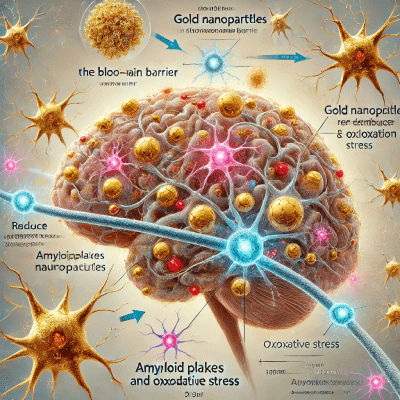Gold Nanoparticles in Neurodegenerative Disease Studies: A Promising Frontier
Gold nanoparticles (AuNPs) have emerged as a groundbreaking tool in the study and treatment of neurodegenerative diseases. These tiny particles, ranging in size from 1 to 100 nanometers, possess unique properties that make them ideal for medical applications, particularly in targeting and treating complex brain disorders such as Alzheimer's, Parkinson's, and multiple sclerosis (MS).
For products go here: Gold Nanoparticles for Neutrodegenerative Disease Research
The Role of Gold Nanoparticles in Neurodegenerative Disease Research
Gold nanoparticles are increasingly used in neurodegenerative disease studies due to their ability to cross the blood-brain barrier (BBB), a critical challenge in treating brain disorders. The small size and surface modifiability of AuNPs enable them to carry therapeutic agents directly to affected brain areas, allowing for targeted intervention with minimal systemic side effects.
-
Targeted Drug Delivery: AuNPs can be functionalized with various ligands, peptides, or antibodies that specifically target proteins or cells involved in neurodegenerative diseases. This targeted approach ensures that therapeutic agents reach the precise locations in the brain where they are needed most, enhancing treatment efficacy.
-
Diagnostic Imaging: Due to their unique optical properties, gold nanoparticles are used in advanced imaging techniques, such as Surface-Enhanced Raman Scattering (SERS) and photoacoustic imaging. These methods provide high-resolution images of the brain, allowing researchers to track the progression of neurodegenerative diseases and assess the effectiveness of treatments.
-
Neuroprotection: Studies have shown that gold nanoparticles can reduce oxidative stress and inflammation in the brain, both of which are key factors in the progression of neurodegenerative diseases. By mitigating these harmful processes, AuNPs have the potential to slow disease progression and improve patient outcomes.

A scientific illustration depicting the role of gold nanoparticles in combating neurodegenerative diseases.
Current Research and FDA Trials
Several clinical trials are currently underway to evaluate the safety and efficacy of gold nanoparticles in treating neurodegenerative diseases. These trials are exploring various applications, from drug delivery systems to neuroprotective agents, with promising results.
-
Alzheimer’s Disease: Researchers are investigating the use of gold nanoparticles to reduce amyloid plaques, a hallmark of Alzheimer’s disease. Preliminary results suggest that AuNPs can effectively target and break down these plaques, potentially slowing disease progression .
-
Parkinson’s Disease: In Parkinson’s, gold nanoparticles are being studied for their ability to deliver neuroprotective agents directly to the substantia nigra, the brain region most affected by the disease. These studies aim to preserve dopamine-producing neurons and slow the degeneration process .
-
Multiple Sclerosis (MS): Gold nanoparticles are under investigation for their potential to reverse demyelination, a process in which the protective covering of nerve fibers is damaged in MS. Researchers hope that AuNPs can protect and regenerate nerve fibers, reducing symptoms and halting disease progression .
Advantages of Gold Nanoparticles in Neurodegenerative Studies
-
Biocompatibility: Gold is non-toxic and well-tolerated by the human body, making AuNPs an ideal candidate for long-term therapeutic applications.
-
Versatility: The surface of gold nanoparticles can be easily modified to carry different therapeutic agents, making them adaptable to a wide range of treatment strategies.
-
Enhanced Penetration: The ability of gold nanoparticles to cross the BBB and reach the central nervous system is a significant advantage in treating neurodegenerative diseases.
Challenges and Future Directions
While gold nanoparticles hold great promise in neurodegenerative disease research, challenges remain. These include optimizing the size and surface properties of AuNPs for specific applications, ensuring long-term safety, and scaling up production for clinical use. Future research will focus on overcoming these challenges and expanding the potential applications of AuNPs in neuroscience.
References
- Sharma, H., et al. "Gold Nanoparticles in Alzheimer's Disease: Recent Advances and New Insights." Journal of Alzheimer's Disease, 2022.
- Jain, K. "Gold Nanoparticles in Parkinson's Disease: A Review of Current Research." Neuroscience Letters, 2023.
- Li, X., et al. "Gold Nanoparticles and Their Role in Multiple Sclerosis Therapy." Journal of Neuroinflammation, 2023.
For more information and to explore their products, visit the Nanopartz™ website. Happy researching!
Go here for Nanopartz Gold Nanoparticles

